ENGG941 - Building Sustainability Analysis: Water, Energy Performance
VerifiedAdded on 2023/06/11
|18
|3140
|68
Case Study
AI Summary
This case study analyzes the building sustainability of a four-bedroom house, focusing on water performance, energy performance, and indoor thermal comfort using the Building Sustainability Index (BASIX) online tool. The analysis identifies shortcomings in the original design's BASIX score for water performance due to the lack of rainwater tanks, inefficient water fixtures, and landscaping choices. It proposes solutions like installing rainwater tanks, upgrading to water-efficient fixtures, and using low-water plants to improve water performance and achieve higher BASIX scores. The study also addresses thermal comfort issues, such as inadequate wall and ceiling insulation, improper window shading, and suboptimal floor design, suggesting improvements like maximizing north-facing glazing, insulating walls and ceilings, and optimizing window placement and shading. The document emphasizes the importance of these factors in achieving a sustainable built environment and meeting BASIX requirements. Desklib provides solved assignments and past papers for students.
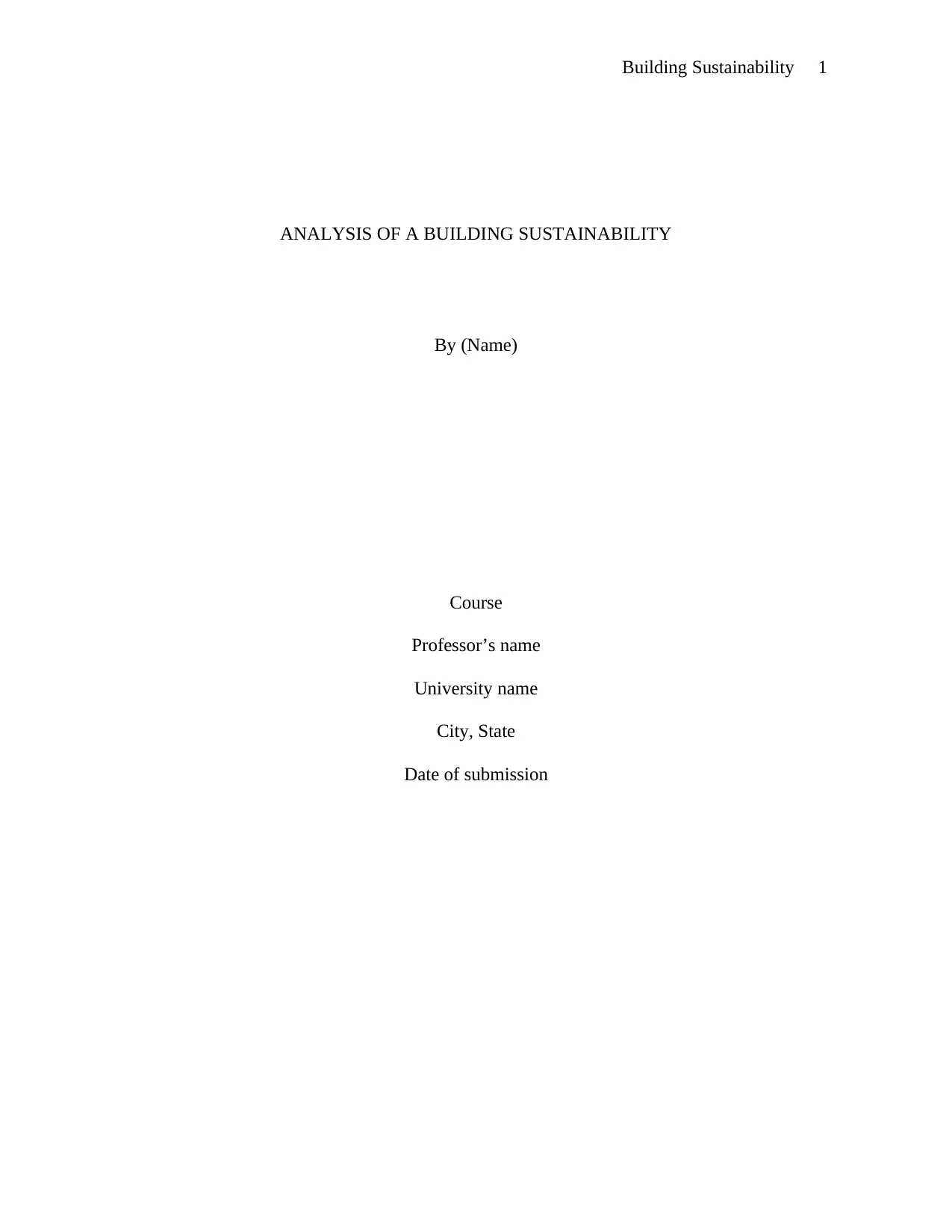
Building Sustainability 1
ANALYSIS OF A BUILDING SUSTAINABILITY
By (Name)
Course
Professor’s name
University name
City, State
Date of submission
ANALYSIS OF A BUILDING SUSTAINABILITY
By (Name)
Course
Professor’s name
University name
City, State
Date of submission
Paraphrase This Document
Need a fresh take? Get an instant paraphrase of this document with our AI Paraphraser
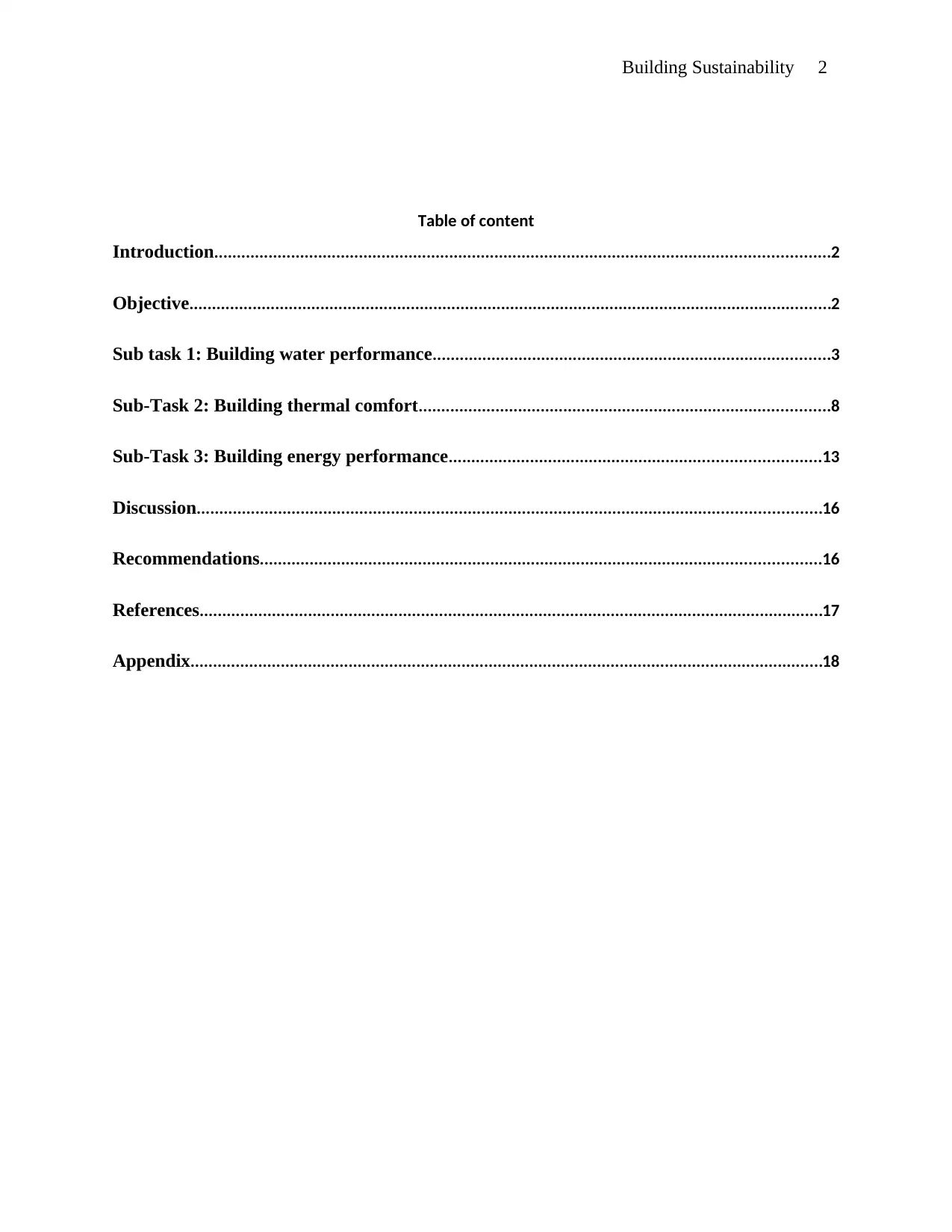
Building Sustainability 2
Table of content
Introduction........................................................................................................................................2
Objective..............................................................................................................................................2
Sub task 1: Building water performance........................................................................................3
Sub-Task 2: Building thermal comfort...........................................................................................8
Sub-Task 3: Building energy performance..................................................................................13
Discussion..........................................................................................................................................16
Recommendations............................................................................................................................16
References..........................................................................................................................................17
Appendix............................................................................................................................................18
Table of content
Introduction........................................................................................................................................2
Objective..............................................................................................................................................2
Sub task 1: Building water performance........................................................................................3
Sub-Task 2: Building thermal comfort...........................................................................................8
Sub-Task 3: Building energy performance..................................................................................13
Discussion..........................................................................................................................................16
Recommendations............................................................................................................................16
References..........................................................................................................................................17
Appendix............................................................................................................................................18
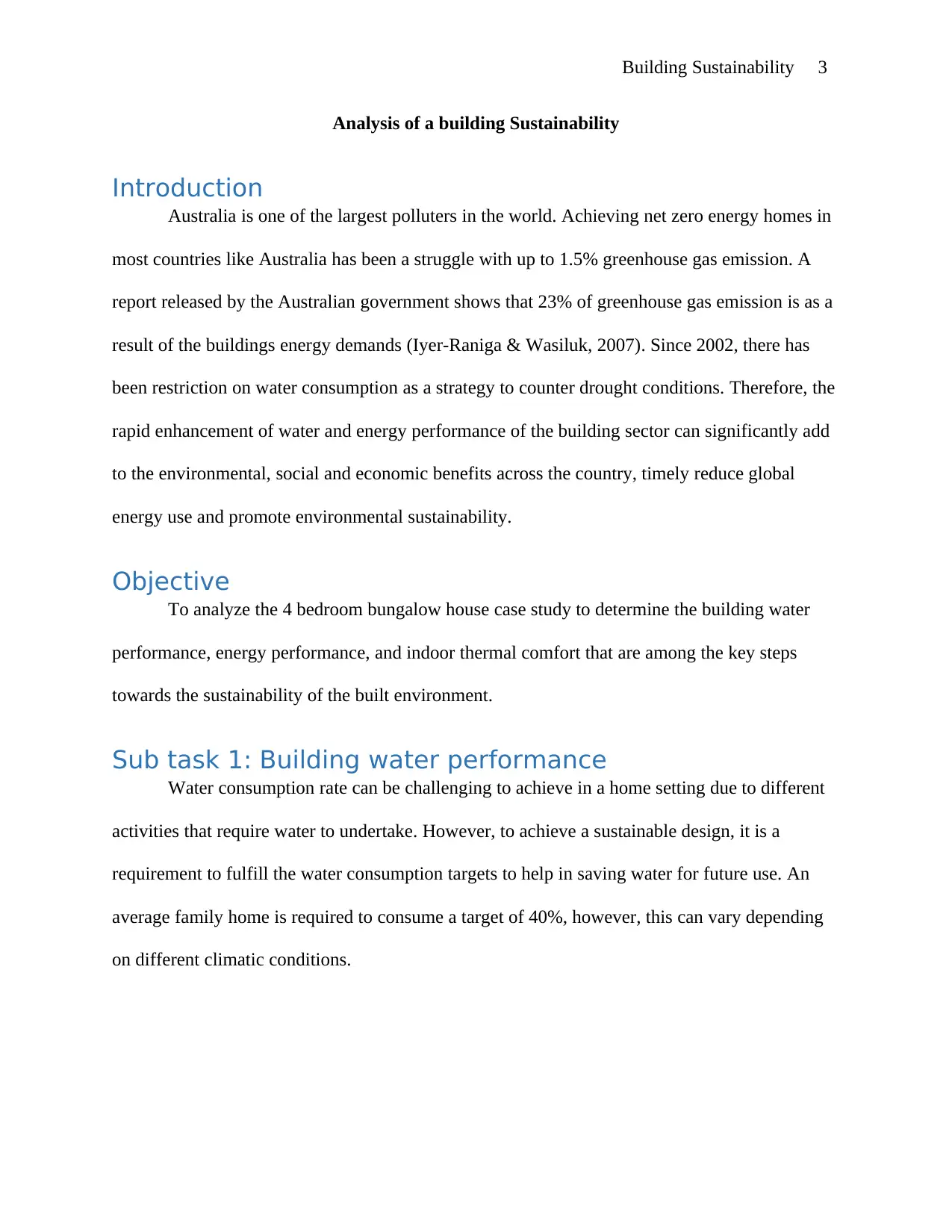
Building Sustainability 3
Analysis of a building Sustainability
Introduction
Australia is one of the largest polluters in the world. Achieving net zero energy homes in
most countries like Australia has been a struggle with up to 1.5% greenhouse gas emission. A
report released by the Australian government shows that 23% of greenhouse gas emission is as a
result of the buildings energy demands (Iyer-Raniga & Wasiluk, 2007). Since 2002, there has
been restriction on water consumption as a strategy to counter drought conditions. Therefore, the
rapid enhancement of water and energy performance of the building sector can significantly add
to the environmental, social and economic benefits across the country, timely reduce global
energy use and promote environmental sustainability.
Objective
To analyze the 4 bedroom bungalow house case study to determine the building water
performance, energy performance, and indoor thermal comfort that are among the key steps
towards the sustainability of the built environment.
Sub task 1: Building water performance
Water consumption rate can be challenging to achieve in a home setting due to different
activities that require water to undertake. However, to achieve a sustainable design, it is a
requirement to fulfill the water consumption targets to help in saving water for future use. An
average family home is required to consume a target of 40%, however, this can vary depending
on different climatic conditions.
Analysis of a building Sustainability
Introduction
Australia is one of the largest polluters in the world. Achieving net zero energy homes in
most countries like Australia has been a struggle with up to 1.5% greenhouse gas emission. A
report released by the Australian government shows that 23% of greenhouse gas emission is as a
result of the buildings energy demands (Iyer-Raniga & Wasiluk, 2007). Since 2002, there has
been restriction on water consumption as a strategy to counter drought conditions. Therefore, the
rapid enhancement of water and energy performance of the building sector can significantly add
to the environmental, social and economic benefits across the country, timely reduce global
energy use and promote environmental sustainability.
Objective
To analyze the 4 bedroom bungalow house case study to determine the building water
performance, energy performance, and indoor thermal comfort that are among the key steps
towards the sustainability of the built environment.
Sub task 1: Building water performance
Water consumption rate can be challenging to achieve in a home setting due to different
activities that require water to undertake. However, to achieve a sustainable design, it is a
requirement to fulfill the water consumption targets to help in saving water for future use. An
average family home is required to consume a target of 40%, however, this can vary depending
on different climatic conditions.
⊘ This is a preview!⊘
Do you want full access?
Subscribe today to unlock all pages.

Trusted by 1+ million students worldwide
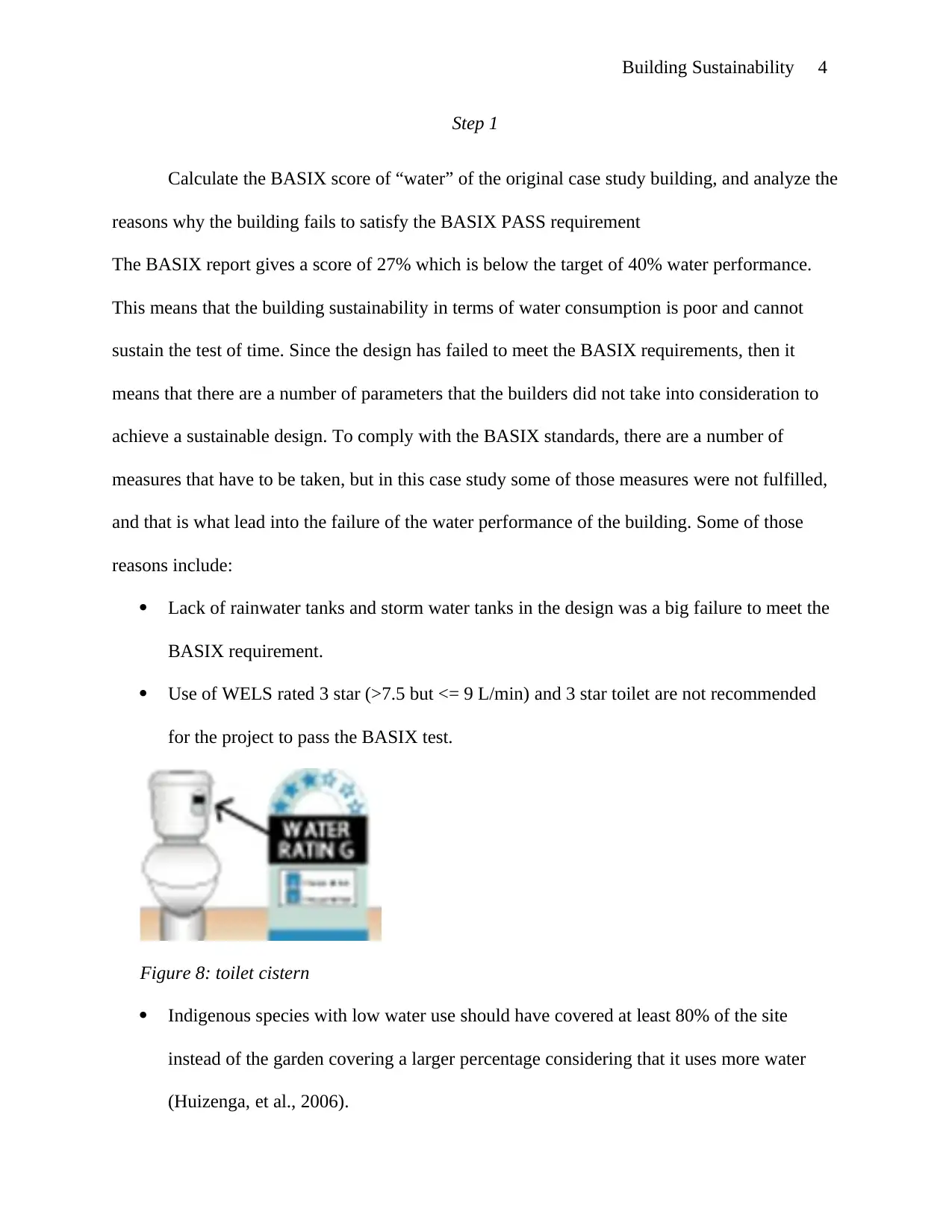
Building Sustainability 4
Step 1
Calculate the BASIX score of “water” of the original case study building, and analyze the
reasons why the building fails to satisfy the BASIX PASS requirement
The BASIX report gives a score of 27% which is below the target of 40% water performance.
This means that the building sustainability in terms of water consumption is poor and cannot
sustain the test of time. Since the design has failed to meet the BASIX requirements, then it
means that there are a number of parameters that the builders did not take into consideration to
achieve a sustainable design. To comply with the BASIX standards, there are a number of
measures that have to be taken, but in this case study some of those measures were not fulfilled,
and that is what lead into the failure of the water performance of the building. Some of those
reasons include:
Lack of rainwater tanks and storm water tanks in the design was a big failure to meet the
BASIX requirement.
Use of WELS rated 3 star (>7.5 but <= 9 L/min) and 3 star toilet are not recommended
for the project to pass the BASIX test.
Figure 8: toilet cistern
Indigenous species with low water use should have covered at least 80% of the site
instead of the garden covering a larger percentage considering that it uses more water
(Huizenga, et al., 2006).
Step 1
Calculate the BASIX score of “water” of the original case study building, and analyze the
reasons why the building fails to satisfy the BASIX PASS requirement
The BASIX report gives a score of 27% which is below the target of 40% water performance.
This means that the building sustainability in terms of water consumption is poor and cannot
sustain the test of time. Since the design has failed to meet the BASIX requirements, then it
means that there are a number of parameters that the builders did not take into consideration to
achieve a sustainable design. To comply with the BASIX standards, there are a number of
measures that have to be taken, but in this case study some of those measures were not fulfilled,
and that is what lead into the failure of the water performance of the building. Some of those
reasons include:
Lack of rainwater tanks and storm water tanks in the design was a big failure to meet the
BASIX requirement.
Use of WELS rated 3 star (>7.5 but <= 9 L/min) and 3 star toilet are not recommended
for the project to pass the BASIX test.
Figure 8: toilet cistern
Indigenous species with low water use should have covered at least 80% of the site
instead of the garden covering a larger percentage considering that it uses more water
(Huizenga, et al., 2006).
Paraphrase This Document
Need a fresh take? Get an instant paraphrase of this document with our AI Paraphraser
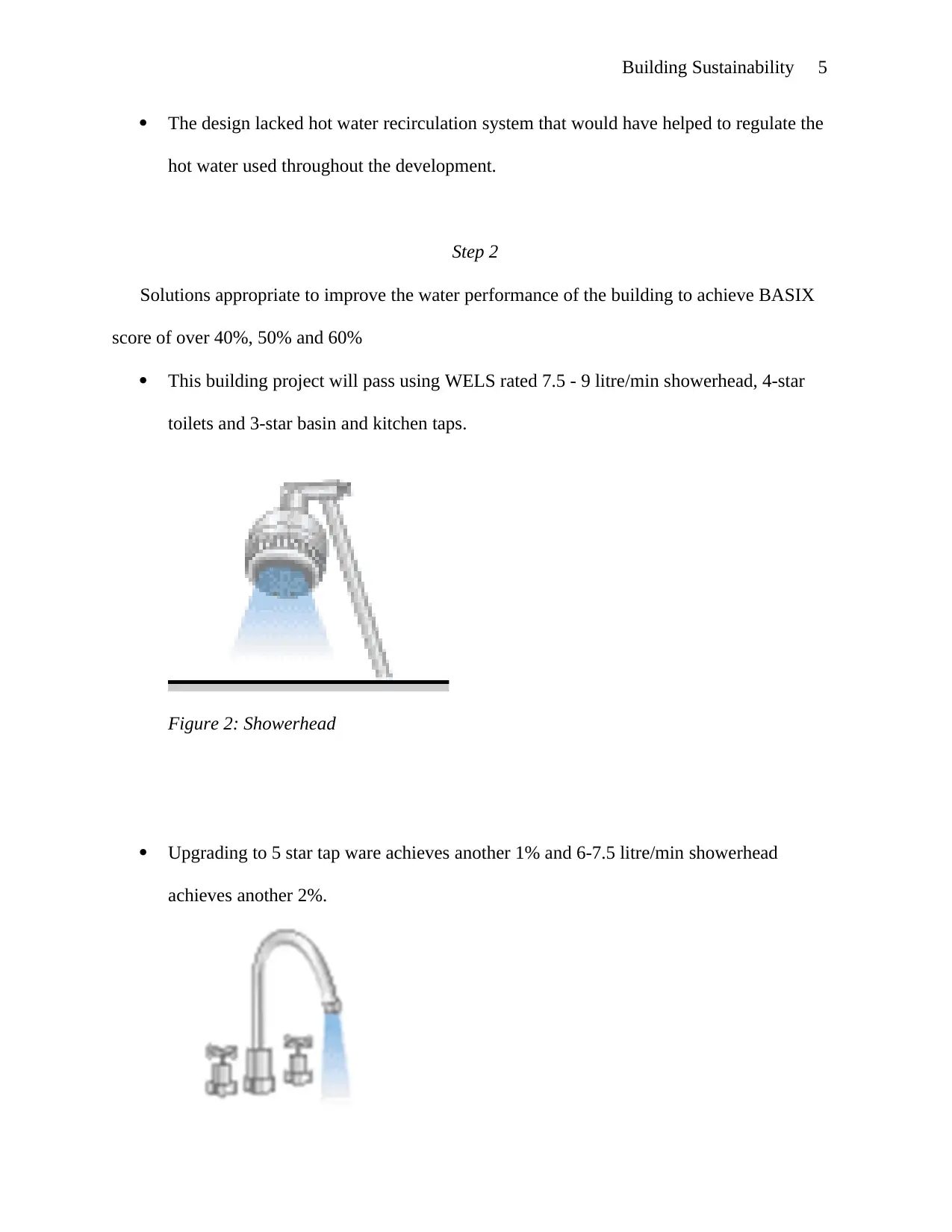
Building Sustainability 5
The design lacked hot water recirculation system that would have helped to regulate the
hot water used throughout the development.
Step 2
Solutions appropriate to improve the water performance of the building to achieve BASIX
score of over 40%, 50% and 60%
This building project will pass using WELS rated 7.5 - 9 litre/min showerhead, 4-star
toilets and 3-star basin and kitchen taps.
Figure 2: Showerhead
Upgrading to 5 star tap ware achieves another 1% and 6-7.5 litre/min showerhead
achieves another 2%.
The design lacked hot water recirculation system that would have helped to regulate the
hot water used throughout the development.
Step 2
Solutions appropriate to improve the water performance of the building to achieve BASIX
score of over 40%, 50% and 60%
This building project will pass using WELS rated 7.5 - 9 litre/min showerhead, 4-star
toilets and 3-star basin and kitchen taps.
Figure 2: Showerhead
Upgrading to 5 star tap ware achieves another 1% and 6-7.5 litre/min showerhead
achieves another 2%.
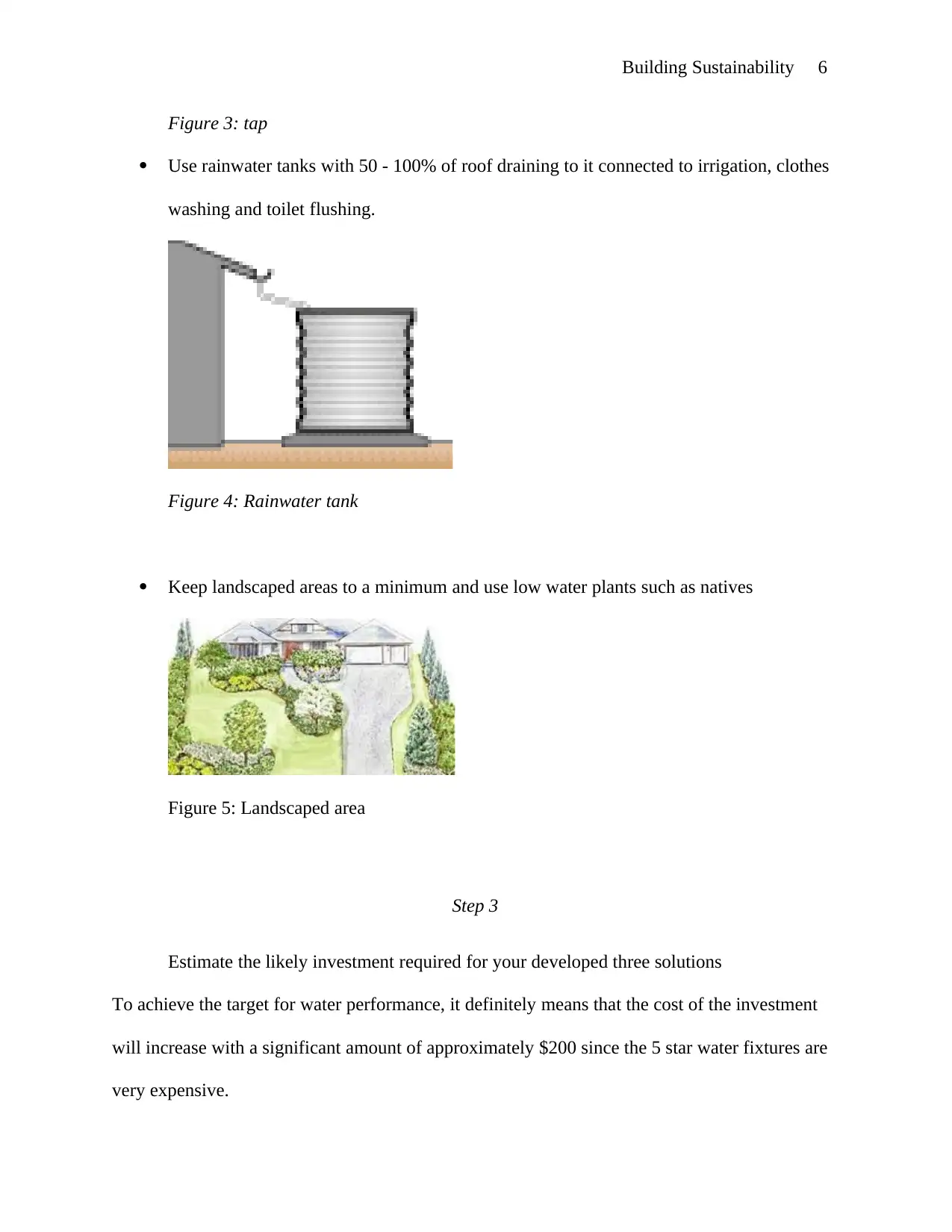
Building Sustainability 6
Figure 3: tap
Use rainwater tanks with 50 - 100% of roof draining to it connected to irrigation, clothes
washing and toilet flushing.
Figure 4: Rainwater tank
Keep landscaped areas to a minimum and use low water plants such as natives
Figure 5: Landscaped area
Step 3
Estimate the likely investment required for your developed three solutions
To achieve the target for water performance, it definitely means that the cost of the investment
will increase with a significant amount of approximately $200 since the 5 star water fixtures are
very expensive.
Figure 3: tap
Use rainwater tanks with 50 - 100% of roof draining to it connected to irrigation, clothes
washing and toilet flushing.
Figure 4: Rainwater tank
Keep landscaped areas to a minimum and use low water plants such as natives
Figure 5: Landscaped area
Step 3
Estimate the likely investment required for your developed three solutions
To achieve the target for water performance, it definitely means that the cost of the investment
will increase with a significant amount of approximately $200 since the 5 star water fixtures are
very expensive.
⊘ This is a preview!⊘
Do you want full access?
Subscribe today to unlock all pages.

Trusted by 1+ million students worldwide
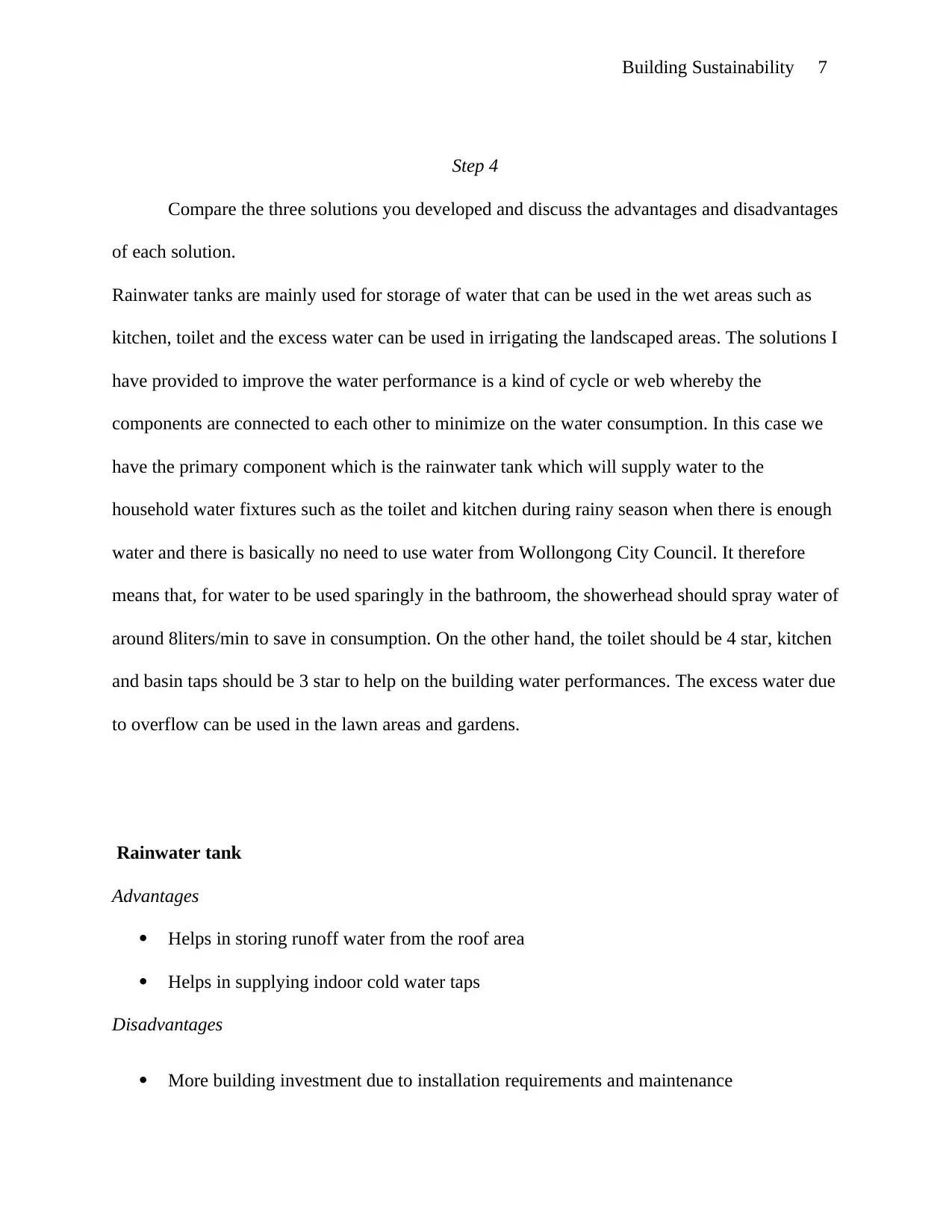
Building Sustainability 7
Step 4
Compare the three solutions you developed and discuss the advantages and disadvantages
of each solution.
Rainwater tanks are mainly used for storage of water that can be used in the wet areas such as
kitchen, toilet and the excess water can be used in irrigating the landscaped areas. The solutions I
have provided to improve the water performance is a kind of cycle or web whereby the
components are connected to each other to minimize on the water consumption. In this case we
have the primary component which is the rainwater tank which will supply water to the
household water fixtures such as the toilet and kitchen during rainy season when there is enough
water and there is basically no need to use water from Wollongong City Council. It therefore
means that, for water to be used sparingly in the bathroom, the showerhead should spray water of
around 8liters/min to save in consumption. On the other hand, the toilet should be 4 star, kitchen
and basin taps should be 3 star to help on the building water performances. The excess water due
to overflow can be used in the lawn areas and gardens.
Rainwater tank
Advantages
Helps in storing runoff water from the roof area
Helps in supplying indoor cold water taps
Disadvantages
More building investment due to installation requirements and maintenance
Step 4
Compare the three solutions you developed and discuss the advantages and disadvantages
of each solution.
Rainwater tanks are mainly used for storage of water that can be used in the wet areas such as
kitchen, toilet and the excess water can be used in irrigating the landscaped areas. The solutions I
have provided to improve the water performance is a kind of cycle or web whereby the
components are connected to each other to minimize on the water consumption. In this case we
have the primary component which is the rainwater tank which will supply water to the
household water fixtures such as the toilet and kitchen during rainy season when there is enough
water and there is basically no need to use water from Wollongong City Council. It therefore
means that, for water to be used sparingly in the bathroom, the showerhead should spray water of
around 8liters/min to save in consumption. On the other hand, the toilet should be 4 star, kitchen
and basin taps should be 3 star to help on the building water performances. The excess water due
to overflow can be used in the lawn areas and gardens.
Rainwater tank
Advantages
Helps in storing runoff water from the roof area
Helps in supplying indoor cold water taps
Disadvantages
More building investment due to installation requirements and maintenance
Paraphrase This Document
Need a fresh take? Get an instant paraphrase of this document with our AI Paraphraser
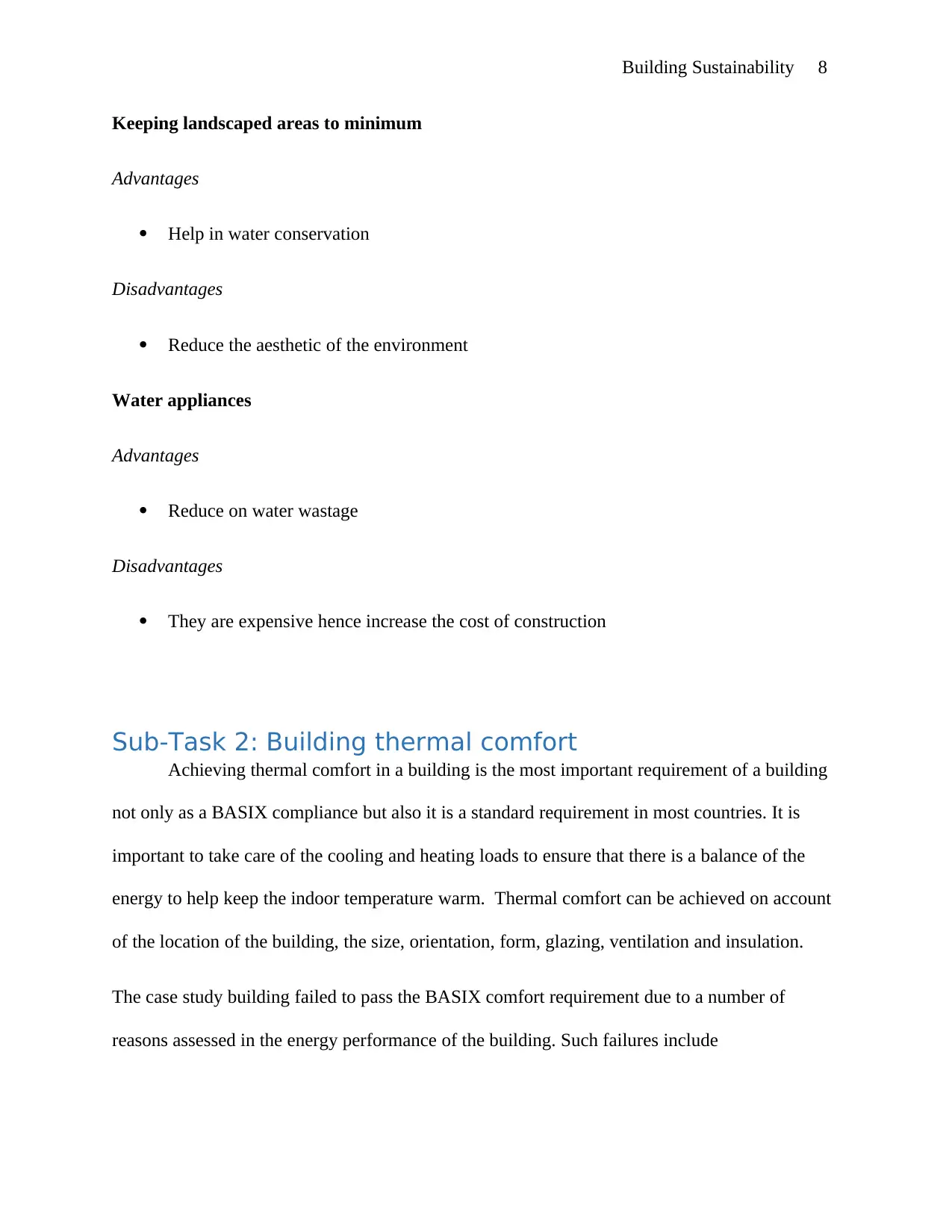
Building Sustainability 8
Keeping landscaped areas to minimum
Advantages
Help in water conservation
Disadvantages
Reduce the aesthetic of the environment
Water appliances
Advantages
Reduce on water wastage
Disadvantages
They are expensive hence increase the cost of construction
Sub-Task 2: Building thermal comfort
Achieving thermal comfort in a building is the most important requirement of a building
not only as a BASIX compliance but also it is a standard requirement in most countries. It is
important to take care of the cooling and heating loads to ensure that there is a balance of the
energy to help keep the indoor temperature warm. Thermal comfort can be achieved on account
of the location of the building, the size, orientation, form, glazing, ventilation and insulation.
The case study building failed to pass the BASIX comfort requirement due to a number of
reasons assessed in the energy performance of the building. Such failures include
Keeping landscaped areas to minimum
Advantages
Help in water conservation
Disadvantages
Reduce the aesthetic of the environment
Water appliances
Advantages
Reduce on water wastage
Disadvantages
They are expensive hence increase the cost of construction
Sub-Task 2: Building thermal comfort
Achieving thermal comfort in a building is the most important requirement of a building
not only as a BASIX compliance but also it is a standard requirement in most countries. It is
important to take care of the cooling and heating loads to ensure that there is a balance of the
energy to help keep the indoor temperature warm. Thermal comfort can be achieved on account
of the location of the building, the size, orientation, form, glazing, ventilation and insulation.
The case study building failed to pass the BASIX comfort requirement due to a number of
reasons assessed in the energy performance of the building. Such failures include
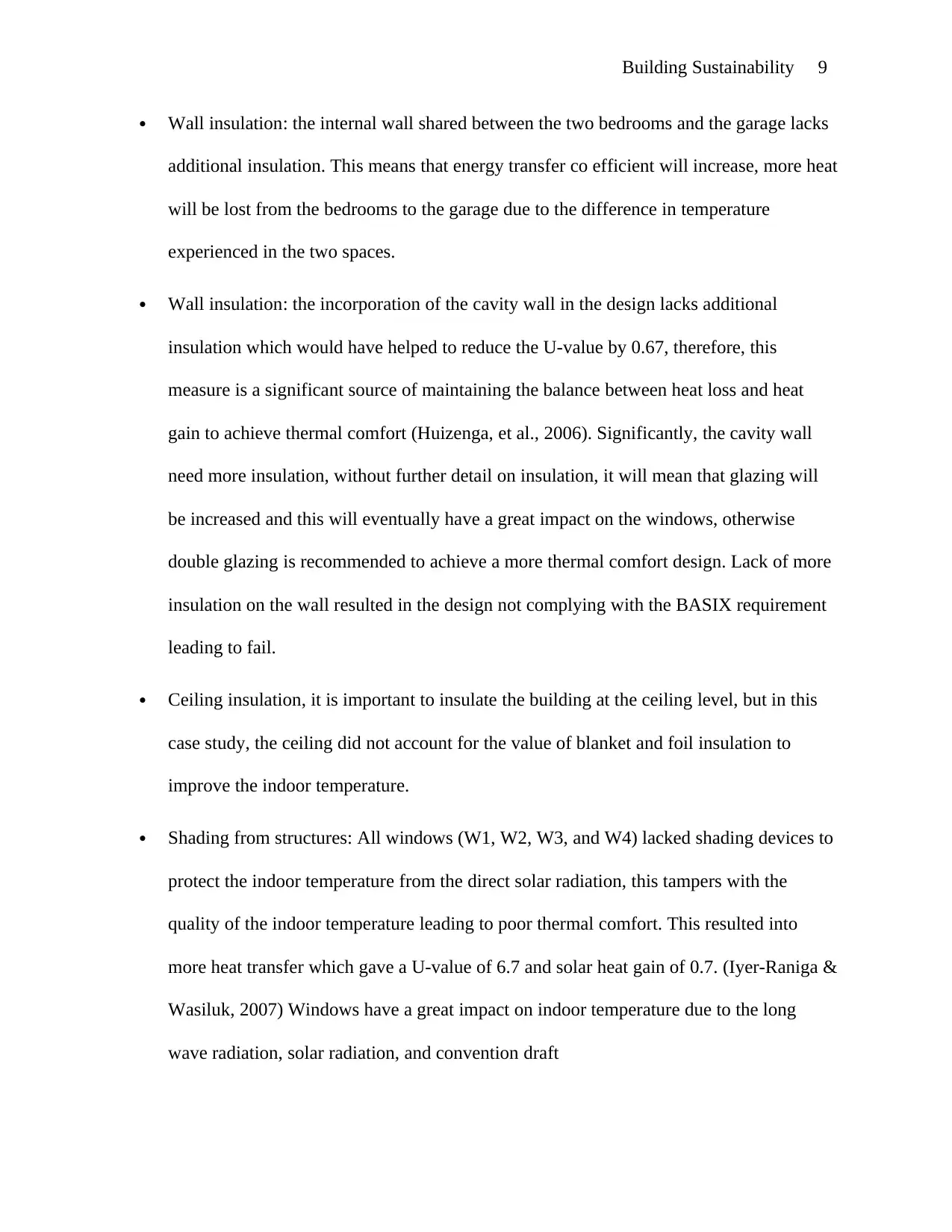
Building Sustainability 9
Wall insulation: the internal wall shared between the two bedrooms and the garage lacks
additional insulation. This means that energy transfer co efficient will increase, more heat
will be lost from the bedrooms to the garage due to the difference in temperature
experienced in the two spaces.
Wall insulation: the incorporation of the cavity wall in the design lacks additional
insulation which would have helped to reduce the U-value by 0.67, therefore, this
measure is a significant source of maintaining the balance between heat loss and heat
gain to achieve thermal comfort (Huizenga, et al., 2006). Significantly, the cavity wall
need more insulation, without further detail on insulation, it will mean that glazing will
be increased and this will eventually have a great impact on the windows, otherwise
double glazing is recommended to achieve a more thermal comfort design. Lack of more
insulation on the wall resulted in the design not complying with the BASIX requirement
leading to fail.
Ceiling insulation, it is important to insulate the building at the ceiling level, but in this
case study, the ceiling did not account for the value of blanket and foil insulation to
improve the indoor temperature.
Shading from structures: All windows (W1, W2, W3, and W4) lacked shading devices to
protect the indoor temperature from the direct solar radiation, this tampers with the
quality of the indoor temperature leading to poor thermal comfort. This resulted into
more heat transfer which gave a U-value of 6.7 and solar heat gain of 0.7. (Iyer-Raniga &
Wasiluk, 2007) Windows have a great impact on indoor temperature due to the long
wave radiation, solar radiation, and convention draft
Wall insulation: the internal wall shared between the two bedrooms and the garage lacks
additional insulation. This means that energy transfer co efficient will increase, more heat
will be lost from the bedrooms to the garage due to the difference in temperature
experienced in the two spaces.
Wall insulation: the incorporation of the cavity wall in the design lacks additional
insulation which would have helped to reduce the U-value by 0.67, therefore, this
measure is a significant source of maintaining the balance between heat loss and heat
gain to achieve thermal comfort (Huizenga, et al., 2006). Significantly, the cavity wall
need more insulation, without further detail on insulation, it will mean that glazing will
be increased and this will eventually have a great impact on the windows, otherwise
double glazing is recommended to achieve a more thermal comfort design. Lack of more
insulation on the wall resulted in the design not complying with the BASIX requirement
leading to fail.
Ceiling insulation, it is important to insulate the building at the ceiling level, but in this
case study, the ceiling did not account for the value of blanket and foil insulation to
improve the indoor temperature.
Shading from structures: All windows (W1, W2, W3, and W4) lacked shading devices to
protect the indoor temperature from the direct solar radiation, this tampers with the
quality of the indoor temperature leading to poor thermal comfort. This resulted into
more heat transfer which gave a U-value of 6.7 and solar heat gain of 0.7. (Iyer-Raniga &
Wasiluk, 2007) Windows have a great impact on indoor temperature due to the long
wave radiation, solar radiation, and convention draft
⊘ This is a preview!⊘
Do you want full access?
Subscribe today to unlock all pages.

Trusted by 1+ million students worldwide
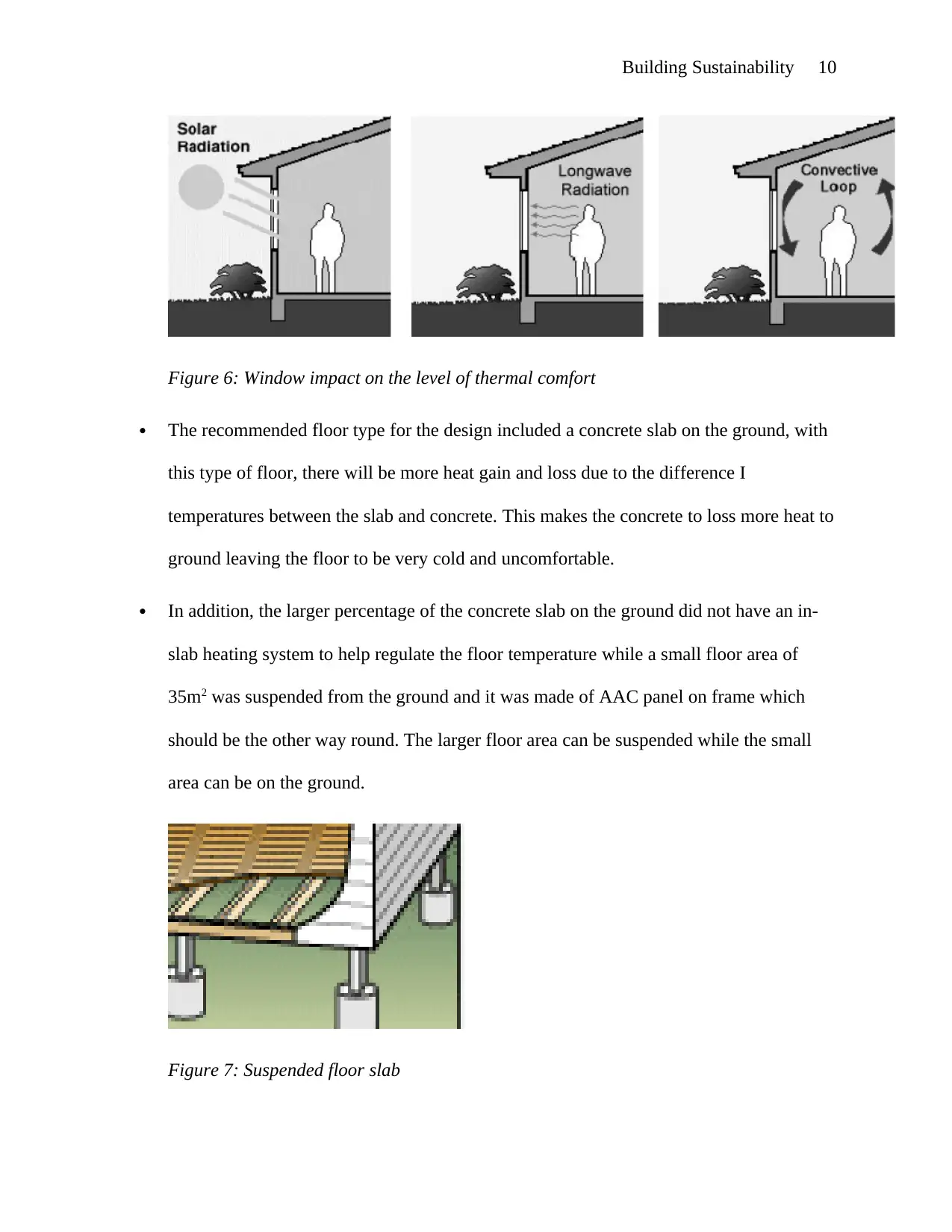
Building Sustainability 10
Figure 6: Window impact on the level of thermal comfort
The recommended floor type for the design included a concrete slab on the ground, with
this type of floor, there will be more heat gain and loss due to the difference I
temperatures between the slab and concrete. This makes the concrete to loss more heat to
ground leaving the floor to be very cold and uncomfortable.
In addition, the larger percentage of the concrete slab on the ground did not have an in-
slab heating system to help regulate the floor temperature while a small floor area of
35m2 was suspended from the ground and it was made of AAC panel on frame which
should be the other way round. The larger floor area can be suspended while the small
area can be on the ground.
Figure 7: Suspended floor slab
Figure 6: Window impact on the level of thermal comfort
The recommended floor type for the design included a concrete slab on the ground, with
this type of floor, there will be more heat gain and loss due to the difference I
temperatures between the slab and concrete. This makes the concrete to loss more heat to
ground leaving the floor to be very cold and uncomfortable.
In addition, the larger percentage of the concrete slab on the ground did not have an in-
slab heating system to help regulate the floor temperature while a small floor area of
35m2 was suspended from the ground and it was made of AAC panel on frame which
should be the other way round. The larger floor area can be suspended while the small
area can be on the ground.
Figure 7: Suspended floor slab
Paraphrase This Document
Need a fresh take? Get an instant paraphrase of this document with our AI Paraphraser
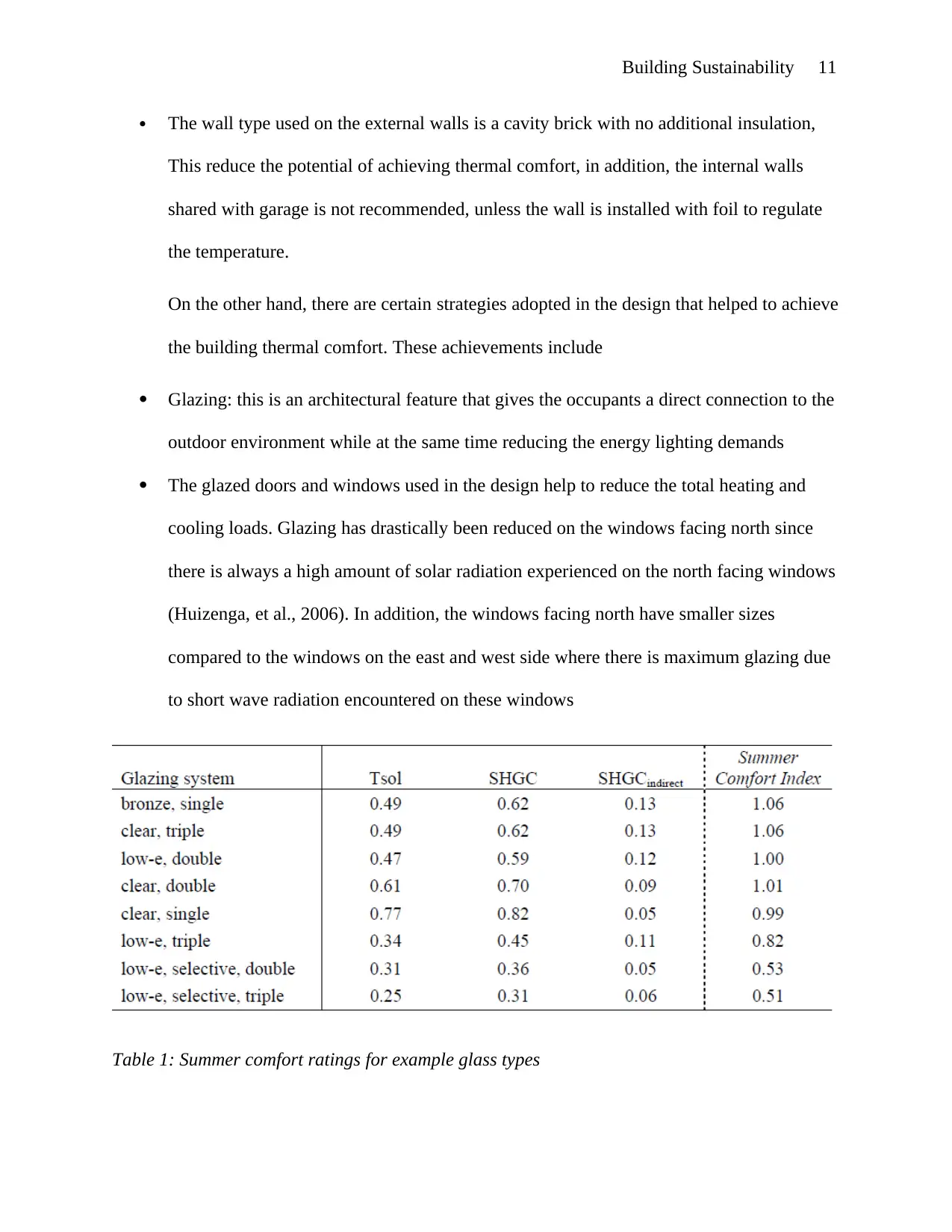
Building Sustainability 11
The wall type used on the external walls is a cavity brick with no additional insulation,
This reduce the potential of achieving thermal comfort, in addition, the internal walls
shared with garage is not recommended, unless the wall is installed with foil to regulate
the temperature.
On the other hand, there are certain strategies adopted in the design that helped to achieve
the building thermal comfort. These achievements include
Glazing: this is an architectural feature that gives the occupants a direct connection to the
outdoor environment while at the same time reducing the energy lighting demands
The glazed doors and windows used in the design help to reduce the total heating and
cooling loads. Glazing has drastically been reduced on the windows facing north since
there is always a high amount of solar radiation experienced on the north facing windows
(Huizenga, et al., 2006). In addition, the windows facing north have smaller sizes
compared to the windows on the east and west side where there is maximum glazing due
to short wave radiation encountered on these windows
Table 1: Summer comfort ratings for example glass types
The wall type used on the external walls is a cavity brick with no additional insulation,
This reduce the potential of achieving thermal comfort, in addition, the internal walls
shared with garage is not recommended, unless the wall is installed with foil to regulate
the temperature.
On the other hand, there are certain strategies adopted in the design that helped to achieve
the building thermal comfort. These achievements include
Glazing: this is an architectural feature that gives the occupants a direct connection to the
outdoor environment while at the same time reducing the energy lighting demands
The glazed doors and windows used in the design help to reduce the total heating and
cooling loads. Glazing has drastically been reduced on the windows facing north since
there is always a high amount of solar radiation experienced on the north facing windows
(Huizenga, et al., 2006). In addition, the windows facing north have smaller sizes
compared to the windows on the east and west side where there is maximum glazing due
to short wave radiation encountered on these windows
Table 1: Summer comfort ratings for example glass types
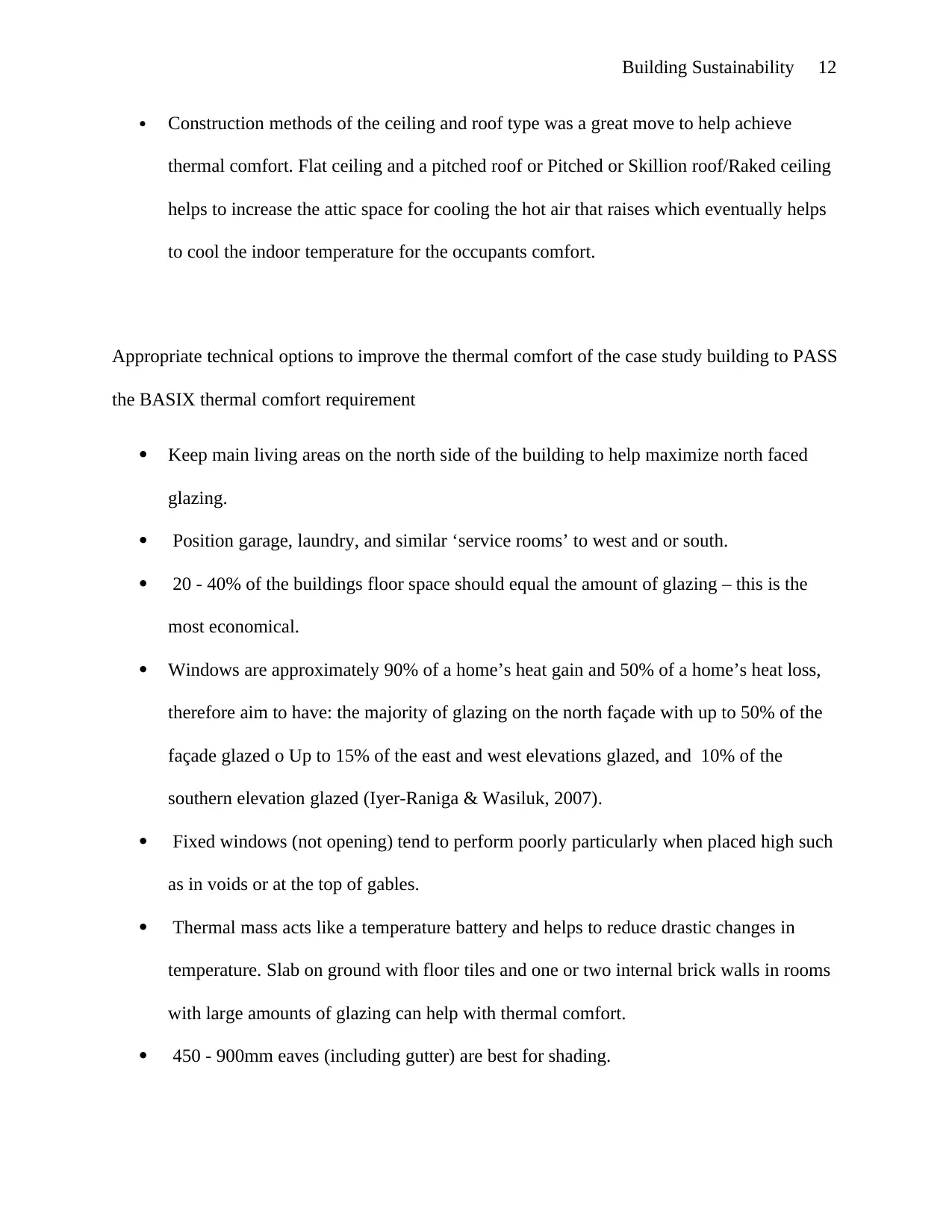
Building Sustainability 12
Construction methods of the ceiling and roof type was a great move to help achieve
thermal comfort. Flat ceiling and a pitched roof or Pitched or Skillion roof/Raked ceiling
helps to increase the attic space for cooling the hot air that raises which eventually helps
to cool the indoor temperature for the occupants comfort.
Appropriate technical options to improve the thermal comfort of the case study building to PASS
the BASIX thermal comfort requirement
Keep main living areas on the north side of the building to help maximize north faced
glazing.
Position garage, laundry, and similar ‘service rooms’ to west and or south.
20 - 40% of the buildings floor space should equal the amount of glazing – this is the
most economical.
Windows are approximately 90% of a home’s heat gain and 50% of a home’s heat loss,
therefore aim to have: the majority of glazing on the north façade with up to 50% of the
façade glazed o Up to 15% of the east and west elevations glazed, and 10% of the
southern elevation glazed (Iyer-Raniga & Wasiluk, 2007).
Fixed windows (not opening) tend to perform poorly particularly when placed high such
as in voids or at the top of gables.
Thermal mass acts like a temperature battery and helps to reduce drastic changes in
temperature. Slab on ground with floor tiles and one or two internal brick walls in rooms
with large amounts of glazing can help with thermal comfort.
450 - 900mm eaves (including gutter) are best for shading.
Construction methods of the ceiling and roof type was a great move to help achieve
thermal comfort. Flat ceiling and a pitched roof or Pitched or Skillion roof/Raked ceiling
helps to increase the attic space for cooling the hot air that raises which eventually helps
to cool the indoor temperature for the occupants comfort.
Appropriate technical options to improve the thermal comfort of the case study building to PASS
the BASIX thermal comfort requirement
Keep main living areas on the north side of the building to help maximize north faced
glazing.
Position garage, laundry, and similar ‘service rooms’ to west and or south.
20 - 40% of the buildings floor space should equal the amount of glazing – this is the
most economical.
Windows are approximately 90% of a home’s heat gain and 50% of a home’s heat loss,
therefore aim to have: the majority of glazing on the north façade with up to 50% of the
façade glazed o Up to 15% of the east and west elevations glazed, and 10% of the
southern elevation glazed (Iyer-Raniga & Wasiluk, 2007).
Fixed windows (not opening) tend to perform poorly particularly when placed high such
as in voids or at the top of gables.
Thermal mass acts like a temperature battery and helps to reduce drastic changes in
temperature. Slab on ground with floor tiles and one or two internal brick walls in rooms
with large amounts of glazing can help with thermal comfort.
450 - 900mm eaves (including gutter) are best for shading.
⊘ This is a preview!⊘
Do you want full access?
Subscribe today to unlock all pages.

Trusted by 1+ million students worldwide
1 out of 18
Related Documents
Your All-in-One AI-Powered Toolkit for Academic Success.
+13062052269
info@desklib.com
Available 24*7 on WhatsApp / Email
![[object Object]](/_next/static/media/star-bottom.7253800d.svg)
Unlock your academic potential
Copyright © 2020–2025 A2Z Services. All Rights Reserved. Developed and managed by ZUCOL.





